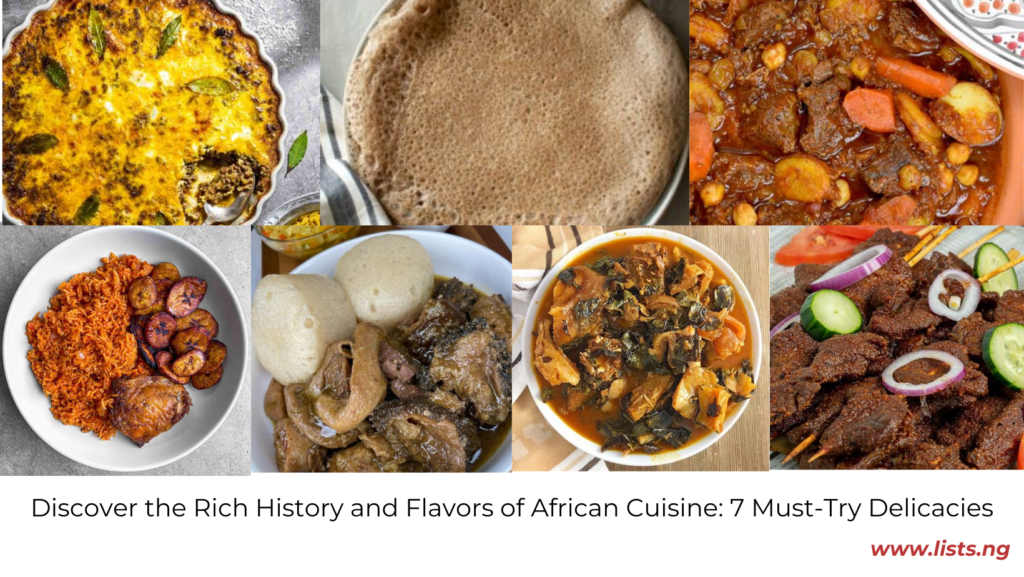Discover the Rich History and Flavors of African Cuisine: 7 Must-Try Delicacies
African cuisine is a vibrant and diverse expression of the continent’s rich cultural heritage. With over 50 countries and more than 2,000 languages, Africa boasts a vast array of culinary traditions waiting to be explored. In our latest article, we delve into the stories behind some of Africa’s most popular foods and provide recipes to try at home. Here are seven African delicacies and their histories:
Jollof Rice (West Africa)
Jollof rice is a staple in West Africa, particularly in Ghana, Nigeria, and Senegal. The origins of Jollof Rice are a source of friendly debate between Ghana and Nigeria, with both countries claiming to have the best Jollof. The history of Jollof rice is said to have started in the Wolof Empire, which ruled from the 13th to the 19th centuries in what is now Senegal and Gambia. The dish was likely influenced by the Portuguese, who introduced tomatoes and peppers to the region. Jollof rice is typically prepared with long grain rice, blended peppers, tomatoes, onions, meat stock, and seasonings. It can be paired with chicken, goat meat, beef, turkey, or any protein of your choice, along with side dishes such as plantain, salad, or moi-moi.
See Recipes to try at home below.
Suya (Nigeria)
Suya is a popular Nigerian dish made from thinly sliced meat, usually beef or chicken, marinated in spices, peanut sauce, and other ingredients, then grilled over an open flame or in an oven. It originated with the Hausa people of northern Nigeria and is a beloved dish at social gatherings. Suya is believed to have been introduced by northern cattlemen who would sit around a campfire and cook the grilled meat skewered on sticks or their knives over an open fire. The ingredients for Suya typically include thinly shredded beef or chicken, yaji pepper, peanut sauce, and Suya spice mix.
Check out recipes from skilled chefs below.
Tagine (Morocco)
Tagine is a slow-cooked stew made with meat, vegetables, and dried fruits, typically cooked in a clay pot with a conical lid. It has its roots in Berber cuisine and is a staple in Moroccan cuisine. Tagine dishes reflect the country’s rich history and diverse cultural influences, combining Berber, Arab, Andalusian, and Mediterranean flavors. Ingredients for Tagine include meat (lamb, beef, or chicken), vegetables (onions, garlic, ginger, bell peppers), dried fruits (dates, prunes, apricots), spices (cumin, coriander, cinnamon, turmeric), and herbs (parsley, cilantro). Different varieties of Tagine include Chicken Tagine with olives and lemon, Beef Tagine with prunes and almonds, Vegetable Tagine with chickpeas and preserved lemons, and Fish Tagine with saffron and cumin.
Here’s a link to the recipe for this wonderful cuisine.
Kenkey (Ghana)
Kenkey is a traditional Ghanaian dish that dates back to the precolonial era. Its origins are attributed to the Ga people, who lived in the coastal regions of Ghana. Kenkey is more than just a meal; it is a symbol of Ghanaian culture and tradition. Its preparation and sharing are often social events, bringing people together and fostering a sense of community and unity. Kenkey is often served at social gatherings such as weddings and funerals. The two main varieties are Ga Kenkey and Fante Kenkey. Kenkey is made from fermented corn dough, which is boiled and then served with a spicy sauce or pepper. The fermentation process involves mixing corn flour with water and allowing it to sit for several days, creating a natural yeast culture. This process gives Kenkey its unique flavor and texture. It can be served with stews, vegetables, and okra stew.
See how this cuisine is being prepared below:
Bobotie (South Africa)
Bobotie is a traditional South African dish with a peculiar blend of flavors and aromatic spices. It is a tasty baked meal made with minced meat, usually beef or lamb, and various ingredients including bread, dried fruit, and spices. Bobotie has its origins in Indonesian cuisine, specifically the island of Java. It was introduced to South Africa by Malay slaves transported to the Cape Colony by the Dutch in the 17th century. The dish evolved over time to include local ingredients and seasonings. Varieties of Bobotie include Cape Malay Bobotie (made with ground beef and lamb, seasoned with cumin, coriander, and turmeric), Indian Bobotie (made with ground lamb and beef, seasoned with cumin, coriander, and cayenne pepper), and Vegetarian Bobotie (made with vegetables, eggs, and spices, topped with a custard-like mixture). The dish can be compared to American meatloaf. Bobotie is made with a mixture of ground beef or lamb, eggs, and spices, topped with a custard-like mixture made from eggs, milk, and spices. The filling is typically flavored with cumin, coriander, and turmeric, giving it a distinctive aroma and taste.
Here’s a quick tutorial on how this cuisine is being prepared:
Ofe Oha (Nigeria)
Ofe Oha is a traditional Igbo soup that originated in Nigeria’s southeastern area. The term “Ofe Oha” means “cocoyam leaf soup” in Igbo. The traditional dish has a similar taste to bitter leaf soup. Ofe Oha represents the Igbo people’s resourcefulness and adaptability, using readily available items to prepare nutritious meals. The bitter flavor of cocoyam leaves reflects life’s hardships and struggles, while the hearty and soothing soup portrays the Igbo people’s resilience and determination. The dish can be made in different ways, with some people using chicken, fish, goat meat, or catfish. However, the traditional preparation involves cocoyam, cocoyam leaves, meat or fish, and spices. The cocoyam leaves are typically harvested from the cocoyam plant, washed, and chopped before being added to the pot. The meat or fish is cooked separately before being added to the soup, along with spices and seasonings. This african dish can be eaten with eba, semo, pounded yam, fufu.
You can find recipes for this dish in the video below.
Injera (Ethiopia)
Injera is a sour, fermented pancake-like flatbread with a slightly spongy texture, traditionally made with teff flour. Injera is an Ethiopian and Eritrean delicacy representing the country’s rich historical and cultural legacy. Its sour flavor is thought to represent the ups and downs of life, while its soft and malleable texture represents flexibility and adaptability. Injera is the primary food of the people and is made from teff flour, water, and natural yeast. The mixture is fermented for several days, giving Injera its distinctive sour taste and spongy texture. Injera is typically used to eat stews, vegetables, and lentils. Leftover Injera can be used for salads, fajitas, fruits, nachos, or vegetable wraps.
Conclusion,
Each dish has a unique history, cultural significance, and story, showcasing the richness and complexity of African cuisine. They highlight Africans’ resourcefulness, adaptation, and persistence in creating nutritious and flavorful meals from readily available resources.



